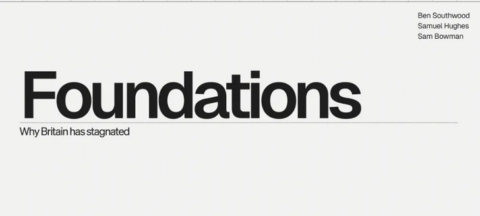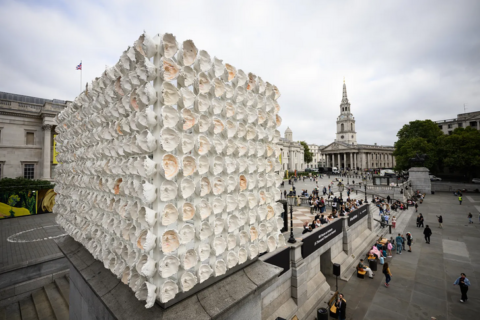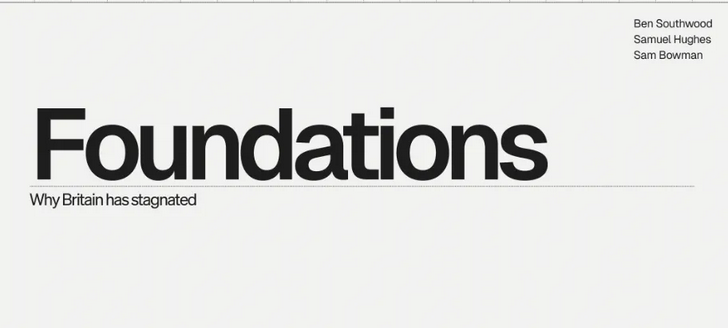Adrian Goldsworthy. Historian and Novelist
Published Jun 5, 2024The latest instalment of the Conquered and the Proud looks at the first few decades of the first century BC. We deal with the final days of Marius, the rise of Sulla, the escalating spiral of civil wars and massacres as Rome’s traditional political system starts breaking down.
Primary Sources – Plutarch, Marius, Sulla, Pompey, Crassus, Cicero and Caesar. Appian Civil Wars and Mithridatic Wars.
Secondary (a small selection) –
P. Brunt, Social Conflicts in the Roman Republic & The Fall of The Roman Republic
A. Keaveney, Sulla – the last Republican
R. Seager, Pompey the Great: A political Biography
September 30, 2024
Sulla, civil war, and dictatorship
September 29, 2024
The “Foundations” essay could apply equally to Canada’s doldrums as it does to Britain
Earlier this week, I linked to the “Foundations” essay by Ben Southwood, Samuel Hughes, and Sam Bowman and it struck me that so much of what they discuss about Britain’s stagnation applied at least as well to Canada. In the National Post, John Ivison concurs:
The “Foundations” essay pointed to moribund GDP per capita growth, among other data points, to make the argument that Britain is standing still economically. (Britain’s economy grew 0.7 per cent a year between 2002 and 2022, Canada’s increased 0.6 per cent a year in the same period, while U.S. output swelled 1.16 per cent a year.)
In relative terms, both countries are getting poorer: in 2002, Canada’s GDP per person was 81 per cent of the U.S.; in 2022, it was 72 per cent. The same figures for the U.K. against the U.S. are 78 per cent in 2002 and, 70 per cent in 2022.
The reason for Britain’s stagnation, the authors argue, is that it has effectively banned investment in transportation, energy and housing — “the foundations it needs to grow.”
Sound familiar?
“The most important economic fact about modern Britain is that it is difficult to build almost anything, anywhere. This prevents investment, increases energy costs and makes it harder for productive economic clusters to expand,” the authors write, saying the result is lower productivity, incomes and tax revenues.
They argued that Britain needs a program of reform with the scale and ambition of the liberalization of the 1980s that focused on cutting taxes, curbing union power and privatizing state-run industries.
“This time we must focus on making it easier to invest in homes, labs, railways, roads, bridges, interconnectors and nuclear reactors,” they write.
That’s a difficult proposition for politicians who are able to resist anything except the temptation to use resources for immediate electoral gratification, rather than investing for a time after they have left office.
Both Canada and Britain are laggards when it comes to investment in infrastructure. While China spent more than five per cent of its GDP on roads, bridges and other infrastructure in 2021, Canada invested just 0.5 per cent (down from 1.3 per cent in 2010) and the U.K. 0.9 per cent.
But the lack of dynamism is not simply political expediency. Rather, it is motivated by an indifference, even a hostility, toward building critical infrastructure.
The Foundations report noted that Britain has not built a reservoir for 30 years, yet faces chronic water shortages in the east of England. Its environmental agency has blocked new development on the basis that it could only be supplied with water by draining environmentally valuable chalk streams. The result is that England’s innovation hub, Cambridge, is barred from expanding, which threatens to strangle the country’s life-sciences industry.
Similar impulses are at work in Canada. Federal Environment Minister Steven Guilbeault said in February that Ottawa would stop investing in new road infrastructure — a position he later clarified to say meant the federal government would not fund large projects like a highway tunnel connecting Quebec City and Levis, Que.
That same sentiment is reflected in the federal Liberal government’s Impact Assessment Act, passed in 2019, which slowed the pace and increased the cost of major project approvals.
On the housing front, a generation of activists emerged who were intent on preventing urban sprawl yet were also opposed to building mid-rise buildings of the kind that eased housing pressures in continental Europe. Constraints on approval are a major contributor to the 3.5-million-unit housing gap because supply has not kept pace with demand.
The consequence of Canada’s regulatory sclerosis is what business veteran Paul Deegan and former clerk of the Privy Council Kevin Lynch in an FP Comment article earlier this year referred to as “an insidious stealth tax on Canadian jobs and growth“.
Taking each of the “foundations” in turn, the depth of the problem becomes clearer — but so do the solutions.
Yankee Go Home!
There’s a major war in continental Europe that might further embroil the NATO alliance in hot combat, so it’s the perfect time for … pulling the US military out of Europe and letting the European NATO allies handle their own defence needs, right?

“Finland flag raising at NATO Headquarters 4 April 2023” by UK Government Picture by Rory Arnold / No 10 Downing Street is licensed under CC BY 2.0 .
For decades, U.S. policy toward Europe stayed the same: Washington anchored itself to the continent via NATO and acted as the region’s main security provider while the European members of NATO accepted U.S. leadership. Today, however, much of the Republican Party has departed from this consensus, opting instead for a policy summed up by Donald Trump’s comments on “delinquent” NATO countries: “If they’re not going to pay, we’re not going to protect.” In other words, the United States may remain committed to Europe, but only if European states pay up. Democrats, for their part, have dug in deeper in response to this shift. President Joe Biden has affirmed the “sacred” Democratic commitment to European defense and trumpeted the admission of Finland and Sweden to NATO as a great achievement of his administration. Kamala Harris has signaled no departure from Biden’s position as the presumptive Democratic presidential nominee.
A debate about the U.S. role in Europe is long overdue, but both sides have wrongly defined the issues and interests at play. In fact, the United States has the same cardinal interest in Europe today that it has had since at least the early 1900s: keeping the continent’s economic and military power divided. In practice, pursuing this goal has meant preventing the emergence of a European hegemon. Unlike the continent in the mid-twentieth century, however, Europe today lacks a candidate for hegemony and, thanks in part to the success of U.S. efforts after 1945 to rebuild and restore prosperity to Western Europe, another hegemonic threat is unlikely to emerge.
The United States should recognize that it has achieved its main goal in Europe. Having successfully ensured that no country can dominate the continent, it should embrace a new approach to the region. Under a revised strategy, the United States would reduce its military presence on the continent, Europeanize NATO, and hand principal responsibility for European security back to its rightful owners: the Europeans.
A Fine Balance
For more than 100 years, the United States has had one enduring national interest in Europe: keeping the continent’s economic and military power split among multiple states by preventing the emergence of a European hegemon that sought to consolidate that power for itself.
In World War I and World War II, Washington went to war to stop Germany from dominating Europe. NATO, founded in 1949, was designed to foreclose the possibility that a single country could take over the continent. As Secretary of State Dean Acheson remarked that year, the two world wars “taught us that the control of Europe by a single aggressive, unfriendly power would constitute an intolerable threat to the national security of the United States.”
U.S. support for NATO was a reasonable move at a time when the Soviet Union was threatening to overrun the continent, wartime memories were fresh, and Germany’s future was unclear. Yet even back then, Washington’s goal was not to take permanent responsibility for European security. Instead, NATO was intended as a temporary expedient to protect Western European states as they recovered from World War II, facilitate Western European efforts to balance Soviet power, and integrate West Germany into a counter-Soviet coalition that would also help civilize German power. In 1951, as the supreme Allied commander in Europe, Dwight Eisenhower noted, “If in ten years, all American troops stationed in Europe for national defense purposes have not been returned to the United States, then this whole project will have failed.”
To that end, Presidents Harry Truman and Eisenhower tried to pull together a “Third Force” of European power by encouraging France, the United Kingdom, West Germany, and other Western European states to combine their political, economic, and military resources against the Soviet Union. Once formed, this Third Force would relieve the United States of the duty to serve as Europe’s first line of defense. Only as it became clear in the late 1950s and early 1960s that Western European states worried as much about Germany as they worried about the Soviet Union did the United States reluctantly accept a more enduring role in the alliance.
QotD: Pyrrhus, King of Epirus
Last time, we sought to assess some of the assumed weaknesses of the Hellenistic phalanx in facing rough terrain and horse archer-centered armies and concluded, fundamentally, that the Hellenistic military system was one that fundamentally worked in a wide variety of environments and against a wide range of opponents.
This week, we’re going to look at Rome’s first experience of that military system, delivered at the hands of Pyrrhus, King of Epirus (r. 297-272). The Pyrrhic Wars (280-275) are always a sticking point in these discussions, because they fit so incongruously with the rest. From 214 to 148, Rome will fight four “Macedonian Wars” and one “Syrian War” and utterly demolish every major Hellenistic army it encounters, winning every single major pitched battle and most of them profoundly lopsidedly. Yet Pyrrhus, fighting the Romans some 65 years earlier manages to defeat Roman armies twice and fight a third to a messy draw, a remarkably better battle record than any other Hellenistic monarch will come anywhere close to achieving. At the same time, Pyrrhus, quite famously, fails to get anywhere with his victories, taking losses he can ill-afford each time (thus the notion of a “Pyrrhic victory”), while the Roman armies he fights are never entirely destroyed either.
So we’re going to take a more in-depth look at the Pyrrhic Wars, going year-by-year through the campaigns and the three major battles at Heraclea (280), Ausculum (279) and Beneventum (275) and try to see both how Pyrrhus gets a much better result than effectively everyone else with a Hellenistic army and also why it isn’t enough to actually defeat the Romans (or the Carthaginians, who he also fights). As I noted last time, I am going to lean a bit in this reconstruction on P.A. Kent, A History of the Pyrrhic War (2020), which does an admirable job of untangling our deeply tangled and honestly quite rubbish sources for this important conflict.
Believe it or not, we are actually going to believe Plutarch in a fair bit of this. So, you know, brace yourself for that.
Now, Pyrrhus’ campaigns wouldn’t have been possible, as we’ll note, without financial support from Ptolemy II Philadelphus, Antigonus II Gonatus and Ptolemy Keraunos. So, as always, if you want to help me raise an Epirote army to invade Italy (NATO really complicates this plan, as compared to the third century, I’ll admit), you can support this project on Patreon.
Bret Devereaux, “Collections: Phalanx’s Twilight, Legion’s Triumph, Part IIIb: Pyrrhus”, A Collection of Unmitigated Pedantry, 2024-03-08.
September 28, 2024
The rise in niqab and hijab use among Muslim women in Britain
In The Conservative Woman, Gillian Dymond discusses the cultural significance of Muslim women’s distinctive styles of clothing in modern Britain:
AS I WENT to the shops the other day in Whitley Bay, a strangely incongruous figure passed me. It was a woman in a niqab. In a recent article on his Substack, Joshua Trevino wrote an elegy for London: “I had not seen this many women in hijabs since a brief stint working in Jordan decades ago, and I had never seen this many women in a niqab, ever.” Up here on the north-east coast of England, it is different. True, even in Newcastle hijabs proliferate, but I had never before encountered the full niqab there, let alone in the small seaside town where I live.
The Government, I understand, are considering bringing in a law which would criminalise Islamophobia, as defined by the All-Party Parliamentary Group on British Muslims. “Islamophobia,” this states, “is rooted in racism and is a type of racism that targets expressions of Muslimness or perceived Muslimness“.
This, as Andrew Doyle points out here, is nonsense, incorrectly conflating a belief-system with racial identity. Let’s be accurate: Muslims can be of any race, English included. Moreover, different Muslims exhibit different kinds and degrees of “Muslimness”, from the Sufi, mystically seeking the divine, through the undogmatic, many of whom happily dispense with headscarf and hijab and the more bellicose interpretations of the holy books, to the kind of male fanatic who, on seeing a female co-religionist wearing Western dress and sporting lipstick, seizes her by the hair and slams her head on the dashboard of the car she has been shamelessly driving.
There is a variety of “Muslimness”, in short, whose intolerance cannot be tolerated in a tolerant society, and whose existence requires not protective legislation, but public acknowledgement of its incompatibility with the British way of life.
I do not know how the woman whose eyes peered through the slit in her black draperies felt about parading her glaring lack of integration on a street in north-east England. Did she go proudly and self-righteously into the alien throng, or had she been forced out of the house, heart pounding, to run the gauntlet of raised eyebrows in her eye-catching gear? What did she think of the women around her, hair and faces exposed, arms bare to soak up every last ray of autumnal sunshine, some of them, fresh from the beach, wearing shorts? Did she despise their “immodesty”? Did she envy them?
Who knows? There can be no casual breaching of the niqab’s anonymity, no spontaneous communication, when confronted by a garment which puts up barricades against the usual signals and responses of easy human intercourse.
On the other hand, the mentality of the men who insist on enveloping their wives and daughters head-to-foot in long black shrouds before they are allowed out in public is very clear indeed. These men have been taught to view women as assets to be protected, and they no doubt believe that the heavy-handed protection they impose is necessary, because they take it for granted that no man is able, or should be expected, to control his sexual urges in the face of female allurements. As for any woman who does not remain decently covered in deference to the male’s helpless susceptibility, she should know the consequences, and deserves everything coming to her.
September 27, 2024
So much “modern art” ages like milk
Most of Andrew Doyle’s latest column is behind the paywall, but I found myself nodding along to the first portion about the descent of modern art:
The works on display at New York’s Museum of Modern Art (MOMA) have been curated with care. On my recent visit I began on the fifth floor, where you can admire art from the 1880s until the 1940s. On the fourth floor you will find works from the 1950s to the 1970s, and then two floors below are the collections from the 1980s until the present day. I wonder whether this arrangement is deliberate; the literal descent of the visitor from one floor to the next reflecting the figurative descent of artistic quality through the century.
And so while on the upper floor you can admire the melting clocks of Salvador Dalí’s most famous and haunting work, The Persistence of Memory (1931), and René Magritte’s The Lovers (1928), a curious meditation on romanticised desire, by the time you reach the second floor there are some cuddly toys glued together into clumps which are dangling from the ceiling. I didn’t bother to check who was responsible for this nonsense.
I have often tried to defend some of the more intriguing efforts at modern conceptual art, but I also recognise that we must be able to admit when art is simply bad. I felt the same when I saw the most recent sculpture to grace the fourth plinth in Trafalgar Square. It is a piece by Mexican artist Teresa Margolles entitled Mil Veces un Instante. It consists of over seven-hundred death masks of trans, non-binary and gender non-conforming people arranged into a cuboid. The faces are meant to represent those who have been the victims of violence, including the artist’s friend Karla who was murdered in Juárez in December 2015.
I don’t doubt the sincerity of the passion behind the project, or how the tragedy of this death informed the vision of the piece, but as a work of art it is banal. Like many conceptual pieces inspired by voguish identity politics, it is propagandistic and uninspiring. The Pink News has claimed that those who dislike the piece are “bigots”. I would say they simply have good taste.
I suppose it is an improvement on Heather Phillipson’s godawful “The End”, a sculpture of a dollop of whipped cream with a cherry, a drone and a fly on the top which was finally taken down from the fourth plinth in 2022. I doubt that anyone except the artist and her close family members were disappointed to see it gone. While I understand the subjectivity of such matters, surely we should be aspiring to higher standards when it comes to art in public spaces?
Evolution of the Karabiner 98k, From Prewar to Kriegsmodell
Forgotten Weapons
Published 7 Nov 2018The Mauser Karabiner 98k began production as an excellent quality rifle, with every nuance of fine fit and finish one would have expected from the Mauser company. World War Two had barely begun by the time a few compromises began to be made to maintain production, however — and by the end of the war the K98k was a mere shadow of its former self. As with the similar deterioration in quality with Japanese Arisaka rifles, the critical mechanical elements of the K98k were just as safe and functional at the very end as the were at the beginning — but the ancillary aspects came crashing down. One might argue that these changes should have been made from the beginning; that issuing an infantry rifle made to the same finish as a fine commercial sporting arm is a silly waste of resources …
(more…)
September 25, 2024
The Korean War 014 – Breakout from the Perimeter! – September 24, 1950
The Korean War by Indy Neidell
Published 24 Sept 2024Last week’s amphibious invasion of Incheon completely surprised the North Koreans, and there are now thousands of UN troops deep in their rear and their logistic system is totally compromised; on top of that, as this week begins in the south, the UN forces begin breaking out of the Pusan Perimeter, first in a trickle, but by the end of the week in a huge torrent of force, running through, around, and over the North Korean forces.
(more…)
The Life and Times of Xerxes
seangabb
Published Jun 10, 2024An occasional lecture for our Classics Week, this was given to provide historical background for a lecture from the Music Department on Handel’s opera “Serse” (1738).
Books by Sean Gabb: https://www.amazon.co.uk/kindle-dbs/e…
His historical novels (under the pen name “Richard Blake”): https://www.amazon.co.uk/Richard-Blak…
If you have enjoyed this lecture, its author might enjoy a bag of coffee, or some other small token of esteem: https://www.amazon.co.uk/hz/wishlist/…
September 24, 2024
British stagnation – “at some point it becomes impossible to grow when investment is banned”
Ed West reviews a new essay by Ben Southwood, Samuel Hughes, and Sam Bowman which tries to identify the underlying reasons for British economic stagnation:
The theme running through the essay is that the British system makes it very hard to invest and extremely expensive and legally difficult to build, making housing and energy costs prohibitive.
While we all know we have fallen in status, “most popular explanations for this are misguided. The Labour manifesto blamed slow British growth on a lack of “strategy” from the Government, by which it means not enough targeted investment winner picking, and too much inequality. Some economists say that the UK’s economic model of private capital ownership is flawed, and that limits on state capital expenditure are the fundamental problem. They also point to more state spending as the solution, but ignore that this investment would face the same barriers and high costs that existing infrastructure projects face, and that deters private investment.”
The problem is that “all of these explanations take the biggest obstacles to growth for granted: at some point it becomes impossible to grow when investment is banned”.
Even before the Russian invasion of Ukraine, the industrial price of energy had tripled in under 20 years. Per capita electricity generation in Britain is only two-thirds that of France, and a third of the US, making us closer to developing countries like Brazil and South Africa than other G7 states. Transport projects are absurdly expensive, mired by planning rules, and all of this helps explain why annual real wages for the median full-time worker are 6.9 per cent lower than in 2008.
In one of the most notorious examples, the authors note that “the planning documentation for the Lower Thames Crossing, a proposed tunnel under the Thames connecting Kent and Essex, runs to 360,000 pages, and the application process alone has cost £297 million. That is more than twice as much as it cost in Norway to actually build the longest road tunnel in the world.”
Britain’s political elites have failed, they argue, because they do not understand the problems, so “they tinker ineffectually, mesmerised by the uncomprehended disaster rising up before them”.
Even “before the pandemic, Americans were 34 percent richer than us in terms of GDP per capita adjusted for purchasing power, and 17 percent more productive per hour … The gap has only widened since then: productivity growth between 2019 and 2023 was 7.6 percent in the United States, and 1.5 percent in Britain … the French and Germans are 15 percent and 18 percent more productive than us respectively.” The gap continues to widen, and on current trends, Poland will be richer than the United Kingdom by the end of the decade.
Britain began to fall behind after the War, but after decades of relative stagnation, its GDP per capita had converged with the US, Germany and France in the 1980s, and our relative wealth peaked in the early Blair years. (Personally, I wonder if one reason for the great Oasis nostalgia is simply that we were rich back then.) If Britain had continued growing in line with its 1979-2008 trends, average income today would be £41,800 instead of £33,500 — a huge difference.
France is the most natural comparison point to Britain, a country “notoriously heavily regulated and dominated by labour unions”. This is sometimes comical to British sensibilities, so that “French workers have been known to strike by kidnapping their chief executives – a practice that the public there reportedly supports – and strikes are so common that French unions have designed special barbecues that fit in tram tracks so they can grill sausages while they march.” Only in France.
It is also heavily taxed, especially in the realm of employment, and yet despite this, French workers are significantly more productive. The reason is that France “does a good job building the things that Britain blocks: housing, infrastructure and energy supply”.
With a slightly smaller population, France has 37 million homes compared to our 30 million. “Those homes are newer, and are more concentrated in the places people want to live: its prosperous cities and holiday regions. The overall geographic extent of Paris’s metropolitan area roughly tripled between 1945 and today, whereas London’s has grown only a few percent.” One quality-of-life indicator is that “800,000 British families have second homes compared to 3.4 million French families“.
They also do transport far better, with 29 tram networks compared to seven in Britain, and six underground metro systems against our three. “Since 1980, France has opened 1,740 miles of high speed rail, compared to just 67 miles in Britain. France has nearly 12,000 kilometres of motorways versus around 4,000 kilometres here … In the last 25 years alone, the French built more miles of motorway than the entire UK motorway network. They are even allowed to drive around 10 miles per hour faster on them.”
Sten Mk5: The Cadillac of the Sten Family
Forgotten Weapons
Published Jun 17, 2024The Sten Mk5 (sometimes written Sten MkV) was really the Cadillac of the Sten series. It was designed in 1943, and featured a full wooden buttstock patterned after the No4 Enfield rifle, as well as an adjustable front sight and bayonet lugs for the Enfield. It has a wooden pistol grip as well (and early production examples also had a wooden vertical front grip). It was mechanically the same as the earlier Stens, simply with the fire control group moved forward to fit the pistol grip.
The Mk5 was not quite as insanely cheap and fast to make as the MkII and MkIII, but by the time it went into production British arms supply had largely caught up to demand, and they could afford to be a bit less economical. The Mk5 was really much better handling than earlier models, and was well liked, seeing combat as early as the invasion of Normandy in June 1944. In total, 527,428 of them were produced and they remained in service until the adoption of the L2 Sterling submachine gun in 1957 (and they were not completely phased out until at least the late 1960s).
(more…)
QotD: Is vexillology considered part of the LGBT sexual spectrum?
If you happen to wander down Regent Street in London this month, you won’t miss the scores of “Progress Pride” flags draped with regimental precision and symmetry. One can’t evade the impression that the nation’s capital has been temporarily taken over by the paramilitary wing of the Care Bears.
But activists love their flags, and Pride Month™ wouldn’t be complete without the full range of other designs to represent the innumerable sexualities and genders that we’ve only just heard of but have apparently always existed.
There are flags to signify people who identify as nonbinary, polyamorous, polysexual, agender, genderfluid, genderqueer, neutrois, two-spirit and many more. If you haven’t heard of all of these terms, don’t worry. There’s a concerted effort in the public sector to fly these flags at every opportunity and educate the bigoted masses. In April, staff at Royal Stoke Hospital were photographed holding a banner with twenty-one of these flags. And in January, Network Rail unveiled its “Pride Pillar” at London Bridge station, which displayed a similarly garish range.
There are flags for pansexuals (those who are attracted to all sexual identities), somnisexuals (those who are only attracted to people in their dreams), parasexuals (those who don’t feel sexual attraction but will have sex for reproductive purposes) and dozens more. There’s even a flag for “allosexuals”, which apparently means anyone capable of experiencing sexual attraction. Presumably “Allo Allo Sexuals” are people who get aroused by dodgy French accents.
Andrew Doyle, “How many flags does one movement need?”, Andrew Doyle, 2024-06-22.
September 23, 2024
Forgotten War Ep3 – Death in the Arakan
HardThrasher
Published 18 Sept 2024Please consider donations of any size to the Burma Star Memorial Fund who aim to ensure remembrance of those who fought with, in and against 14th Army 1941–1945 — https://burmastarmemorial.org/
(more…)
Berlin’s Der Tagesspiegel wants to help you keep your kids from the perils of right-wing ideology
eugyppius on the help Berlin’s leading daily newspaper is offering to their readers whose kids are hearing the siren call of non-progressive politics:
This obviously charming, cheerful and not at all withered or overwrought woman is named Eva Prausner. She is a social worker, and she directs something called the “Project for Strengthening Parents“, which provides “Training, networking, and counselling in the area of family and right-wing extremism”. This means that she runs around telling parents what to do when they suspect their children are succumbing to political wrong-think. And this in turn makes Frau Prausner the woman of the hour, for never before in the history of the Federal Republic have so many undemocratic children bloomed under the noses of so many upstanding democratic parents.
It is very hard to understand how this happened. The leftists and the Greens, after all, have been doing the Lord’s work teaching leftism and Greenism in schools for decades now, but despite their valiant efforts we are rapidly losing our youth to malign antidemocratic forces. It can’t be that elevating leftoid lunacy into an establishment ideology has backfired, transforming the once cool, counter-cultural left into a political movement for middle-aged scolds and schoolmarms – the kind of thing from which teenagers flee in terror. No, nothing could be less plausible. The real reason for the pandemic of right-wing children must simply be that we haven’t indoctrinated them enough. If parents will not do their part and bring indoctrination also to the home, our democracy will collapse and it will be 1933 all over again, just like it was 1933 all over again two weeks ago after the elections in Thüringen and Saxony.
For these reasons, Der Tagesspiegel, Berlin’s largest daily newspaper, interviewed Prausner on her advice for parents who find themselves forced to deal with their evil, right-leaning spawn. The product is a prescient write-up for the ages bearing the headline “Help, my child is turning right-wing! Eight tips for democratic parents with undemocratic children“.
The rightward shift in East Germany is a shift above all among the youngest, as the elections in Saxony and Thüringen have shown. One in three young people there voted for the far right. In Thüringen, as many as 38% of 18- to 34-year-olds cast their ballot for the AfD – more than in any other age group. Many a parent who values living in a democracy will have wondered: “What have we done wrong?”
In Brandenburg, too, it is becoming clear that even the youngest are now leaning towards the right. In the under-16 vote a week before the state election, the AfD came out on top with around 30% … In the state elections on 22 September, the AfD could become the strongest force, thanks in part to young first-time voters.
Do parents still have any influence over their AfD-voting children?
Alas, Prausner is not very certain that they do, but she believes that democratic parents “should at least try” to rescue their children from the grave heresy of voting for the wrong political parties. Children in Brandenburg are particularly endangered, because Brandenburg is largely rural, and Prausner has discovered that the countryside is absolutely dripping with “condensed prejudicial attitudes”. There is so much racial prejudice in the Brandenburg air that it is collecting on cool surfaces, like windows and beer glasses, that is how bad things are there. Also all children everywhere are in danger because the internet is a powerful right-wing force that helps bad organisations like the AfD pump their fascist mind virus directly into millions of young yet-forming cerebral cortices.
QotD: On Roman Values
I wanted to use this week’s fireside to muse a bit on a topic I think I may give a fuller treatment to later this year, which is the disconnect between what it seems many “radical traditionalists” imagine traditional Roman values to be and actual Roman cultural values.
Now, of course it isn’t surprising to see Roman exemplars mobilized in support of this or that value system, as people have been doing that since the Romans. But I think the disconnect between how the Romans actually thought and the way they are imagined to have thought by some of their boosters is revealing, both of the roman worldview and often the intellectual and moral poverty of their would-be-imitators.
In particular, the Romans are sometimes adduced by the “RETVRN” traditionalist crowd as fundamentally masculine, “manly men” – “high testosterone” fellows for whom “manliness” was the chief virtue. Romans (and Greeks) are supposed to be super-buff, great big fellows who most of all value strength. One fellow on Twitter even insisted that the chief Roman value was VIRILITAS, which was quite funny, because virilitas (“manhood, manliness”) is an uncommon word in Latin, but when it appears it is mostly as a polite euphemism for “penis”. Simply put, this vision bears little relation to actual Roman values. Roman encomia or laudationes (speeches in praise of something or someone) don’t usually highlight physical strength, “high testosterone” (a concept the Romans, of course, did not have) or even general “manliness”. Roman statues of emperors and politicians may show them as reasonably fit, but they are not ultra-ripped body-builders or Hollywood heart-throbs.
Bret Devereaux, “Fireside Friday, March 29, 2024 (On Roman Values)”, A Collection of Unmitigated Pedantry, 2024-03-29.










